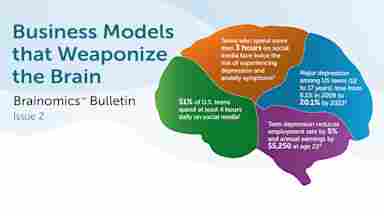Business Models that Weaponize the Brain
Brainomics Issue 2 Open Printable PDF In the traditional economic worldview, producers make stuff that consumers want, where want is expressed by consumers’ preference functions and something called utils.Here in the real world, things are more complicated. Businesses have been pretty good at leveraging cognitive neuroscience for a while. In ancient times (like the 1980s), we called it advertising and later behavioral economics. In more recent times, firms have become very sophisticated, including hiring neuroscientists to design products that elicit feel-good and reward neurotransmitters like dopamine and serotonin to get people to buy more of what the company sells. The brain becomes a weapon against itself. The economic problem for society is that these business models privatize gains while socializing losses. Perhaps the most obvious one is social media, with its addictive properties leading to brain health challenges – including difficulty focusing and (more damaging) anxiety and even depression, reduced earnings and employment, all while the social media companies earn extraordinary profits (well, except the one previously known as Twitter). The company earns profits, but society sees its brain capital depleted.“”

- Rothwell, J. (2023, November 21). Teens spend average of 4.8 hours on social media per day. Gallup.com
- Riehm, K.E. et al. (2019). Associations between time spent using social media and internalizing and externalizing problems among U.S. youth. JAMA Psychiatry, 76(12), 1266-1273.
- U.S. Department of Health and Human Services. (2023). Major depression. National Institute of Mental Health
- Fletcher, J. (2013). Adolescent depression and adult labor market outcomes. Southern Economic Journal, 80(1), 26-49.




